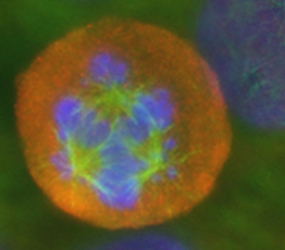No Relaxing for Cancer Cells
Many tumor cells would not be viable due to aberrant chromosome distribution if they had not developed a special trick. A research team led by scientists from the German Cancer Research Center (Deutsches Krebsforschungszentrum, DKFZ) has investigated which genes are responsible for this survival strategy of cancer cells. To this end, they systematically switched off each individual gene of cancer cells using the RNAi method. The researchers have now published an article in Science Translational Medicine revealing that cancer cells rely on the tension of specific protein fibers to be able to multiply. Thus, proteins which maintain this tension are promising targets for new, target-specific anticancer drugs: If they are switched off, cancer cells die.
Joint Press Release of the German Cancer Research Center and Heidelberg University Hospitals
The two centrosomes of a cell are responsible for cell division to proceed correctly. From these polar bodies in the cytoplasm protein fibers form which correctly distribute the duplicated chromosome set to the newly forming daughter cells. Seen under the microscope, these fibers have the shape of a spindle. Cancer cells, however, often have more than two centrosomes. As a result, their spindle fibers do not necessarily assume the normal shape of a spindle with two poles; instead, they can have a dysfunctional, multipolar shape. Such malformed spindles distribute the chromosomes unevenly among the daughter cells, which are then no longer viable.
Hence, tumor cells only survive if they manage to partition their chromosomes correctly in spite of extra centrosomes. To do so, many cancer cells have developed a special trick: They form clusters of centrosomes. Two clusters are formed per cell and a functioning bipolar spindle can develop between these two. Professor Dr. Alwin Krämer, head of a Clinical Cooperation Unit of DKFZ and Heidelberg University Hospitals has recognized this trick as a previously underrated Achilles’ heel of cancer cells, which might be used for destroying them. Jointly with colleagues from DKFZ, Heidelberg University Hospitals, Mannheim Medical Faculty and Mayo Clinic in the U.S., he systematically investigated the question of which genes enable cancer cells to form centrosome clusters and, thus, to escape cell death.
With the support of researchers from the division of Professor Dr. Michael Boutros, DKFZ and Mannheim Medical Faculty, the investigators switched off each individual gene of the cancer cells. Then they searched under the microscope for multipolar, malformed spindles. They found 82 genes which play a role in centrosome clustering. The team took a closer look at 22 of these and investigated their particular role in clustering. In the process, the scientists discovered a key mechanism: For the centrosomes to be bundled into clusters, the spindle fibers need to be under tension. Only tightly stretched spindle fibers will position the centrosomes close enough to each other for clusters to form. A whole range of proteins are responsible for this tension. If their genes are silenced, multipolar spindles form and the cancer cells die. This mechanism might be used for developing new cancer therapies.
“Such a therapy would hit the cancer very specifically, because only tumor cells have extra centrosomes and depend on the survival trick of clustering,” study head Alwin Krämer explains. In the framework of a strategic alliance of DKFZ with Bayer-Schering, the researchers in Krämer’s team are now planning to look among the identified genes for suitable targets for a targeted cancer therapy.
Blanka Leber, Bettina Maier, Florian Fuchs, Jing Chi, Phillip Riffel, Simon Anderhub, Ludmila Wagner, Anthony D. Ho, Jeffrey L. Salisbury, Michael Boutros and Alwin Krämer: Proteins Required for Centrosome Clustering in Cancer Cells. Science Translational Medicine, 2010
A picture for this press release is available on the Internet at:
http://www.dkfz.de/de/presse/pressemitteilungen/2010/images/PM_30_Kraemer.jpg
Picture caption: Multipolar, malformed spindle of a cancer cell
Picture source: German Cancer Research Center
With more than 3,000 employees, the German Cancer Research Center (Deutsches Krebsforschungszentrum, DKFZ) is Germany’s largest biomedical research institute. DKFZ scientists identify cancer risk factors, investigate how cancer progresses and develop new cancer prevention strategies. They are also developing new methods to diagnose tumors more precisely and treat cancer patients more successfully. The DKFZ's Cancer Information Service (KID) provides patients, interested citizens and experts with individual answers to questions relating to cancer.
To transfer promising approaches from cancer research to the clinic and thus improve the prognosis of cancer patients, the DKFZ cooperates with excellent research institutions and university hospitals throughout Germany:
The DKFZ is 90 percent financed by the Federal Ministry of Education and Research and 10 percent by the state of Baden-Württemberg. The DKFZ is a member of the Helmholtz Association of German Research Centers.


